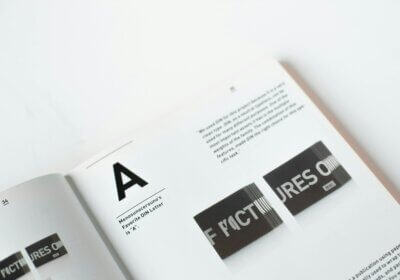One of the most powerful yet sometimes ignored elements in the complex thread of marketing is typography. The skill of selecting and arranging fonts can significantly influence the perception, memory, and action of a message. The silent language is a structure that complements the visual and spoken parts of a design, gradually impacting the emotional response of the viewer.
Not only do fonts have the potential to make text readable, but they also have the ability to stimulate feelings, develop a brand identity, and direct the viewing eye. Careful typographic hierarchy can transform an otherwise unremarkable design into a visually appealing experience. Marketing professionals are able to build designs that resonate, engage, and inspire customers if they have a thorough understanding of the complexities of font selection, spacing, and layout.
Want to know the secret to effective use of typefaces in advertising? Fonts are an all-inclusive toolset for designers and marketers to build a strong brand identity, improve readability, and trigger emotions. Once you’ve mastered these techniques, you’ll be able to take your ideas to the next level, engage your audience, and make an impression that will last. Learn the five freshest ways to spice up your ads with fonts.
Developing a powerful brand identity using typography
More than just a logo or slogan, a company’s identity is a carefully chosen visual language that resonates with the target audience. The use of typography is an essential component in the formation of this identity. Designers are able to create a visual experience that is consistent and memorable by selecting fonts that are in line with the personality and values of the brand.
As an example, a luxury business might choose to use sophisticated serif fonts in order to give an air of timelessness and elegance. On the other hand, a technology company can select sans-serif typefaces that are contemporary and clean in order to convey a sense of innovation and efficiency. Consumer perception of a brand can significantly influence the choice of font family, weight, and style. In order to strengthen brand identification and develop trust with the audience, it is important to apply typography in a consistent manner throughout all marketing materials, including both print and digital products.
Improving readability of visual presentations
In any design, legibility is a top priority. A poorly chosen or implemented font could hinder the viewer’s understanding of the content and lead to frustration. Designers can ensure easy internalization of the message by placing a high value on reading. In order to do this, it is necessary to use typefaces that have distinct letterforms, sufficient spacing between characters and lines, and adequate contrast between the text and the background.
Additionally, designers can use typography to create a visual structure that guides the target audience’s attention. It is possible for designers to highlight important information and establish a clear reading path by utilizing a variety of font sizes, weights, and styles. On the other hand, designers can make the body copy smaller and lighter to promote reading. For instance, headings can be bolder and larger in order to attract attention. Designers have the potential to improve the overall readability and visual attractiveness of their designs by making appropriate use of font arrangements.
Utilizing typography to create emotional impact
Typography is not only a tool from a practical standpoint. It is also a tool from an emotional standpoint. Designers are able to provoke particular feelings and create the ambiance they want by carefully picking fonts and changing the appearance of those fonts. By way of illustration, a font that is bold and dramatic can convey feelings of excitement and urgency, while a font that is delicate and elegant can elicit thoughts of romance and nostalgia.
Additionally, designers can effectively tell stories through typography. It is possible for designers to construct a narrative that is captivating to the reader by utilizing a variety of font sizes, weights, and styles. A typographic story that is well-crafted has the potential to leave an impression that lasts and to promote audience participation. It is possible for designers to develop designs that deeply resonate with their audience if they have a solid understanding of the emotional power of typography.
Playing around with fonts in order to achieve creative effects
Typography extends beyond the commonly used conventional layouts and forms. Designers who push the boundaries of conventional typography can develop visually attractive and innovative designs. It is possible to achieve outcomes that are surprising and captivating by experimenting with different font styles, sizes, and spacing.
Creative techniques can employ the method of playing with negative space. Through the manipulation of the white space surrounding the type, designers are able to create patterns and shapes that are intriguing. In order to produce compositions that are visually appealing, another method is to blend typography with images or photos. When designers are willing to embrace originality and experimentation, they are able to upgrade their designs and differentiate themselves from the competition.
Adapting typography to various forms of media
There is a strong correlation between the media in which typography is utilized and the effectiveness of the font. Designers are required to modify their typographic choices in order to accommodate the particular qualities of each platform, whether they are working with print, the web, or mobile devices.
Considerations for print formats include paper quality, ink color, and printing procedures. When selecting fonts, it is important to select ones that are readable at a variety of sizes and can endure the printing procedures. When it comes to digital designs, it is essential to optimize them for mobile devices and the web. We should apply the principles of responsive design to ensure readability on a wide range of screen sizes. Additionally, the utilization of web fonts can contribute to the provision of flexibility and uniformity across a variety of platforms.
Typography is a really important tool that can make marketing materials more complex and interesting. By catching the complexities of font selection, spacing, and layout, designers can create visually appealing designs that clearly convey their message. Building a solid brand identity, evoking emotions, and directing the viewer’s attention are some of the ways typography plays a crucial role in the effectiveness of marketing strategies.
As time passes and technology advances, the field of typography continues to change. With today’s digital technology, there are so many chances to experiment, which often results in the creation of new fonts. If font designers embrace innovation and keep up with the latest trends, they can create amazing work and really push the boundaries of typographic design.
Typography has the ability to evoke emotions in the viewer. Getting to know how typography affects people’s thoughts and feelings, and using it wisely, helps designers make designs that really resonate with their audience, inspire them, and leave a memorable impression.
Because we understand how stressful it can be to find the perfect font online, visit Whatfontis.com, one of the world’s largest and most experienced font identifiers. ProductHunt recognized Whatfontis as the “Product of the Day” due to its extensive database of over 1 million typefaces. WhatFontIs is independent and can detect fonts, commercial or free. It can identify Google Fonts, unlike any other system.



